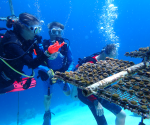“This new hospital is a huge step forward”

SMMC signs contract with developer Inso
GREAT BAY – Hospital-Director Kees Klarenbeek expressed his confidence in the construction of the new hospital on Monday during the signing of the design-build-maintain contract with the Italian contractor Inso. Today reported yesterday a picture on its front page about the signing, but the information came in too late to publish the accompanying story.
“Today we reach an important milestone on the assay to a new hospital for St. Maarten,” SMMC-Director Klarenbeek said in a brief address. He emphasized that the bids for the project had been assesses and scrutinized by a team of 25 people – representatives from the hospital, SZV and the Public Health Ministry.
“Inso is a large international construction company with proven experience in the construction of large and smaller hospitals all over the world and also in the Caribbean,” Klarenbeek said. “We are confident that what has been offered by Inso meets and even exceeds the standards we have established for our new general hospital.”
Klarenbeek praised the cooperation within the tripartite and the transparent approach towards the project. “This will benefit our citizens and those of surrounding islands,’ he said. “There will be a better quality of care and there will be more services. This new hospital is a huge step forward. The existing hospital is too small and not functional anymore. The building is old and expensive to maintain.” The new hospital will have 110 beds – among them six for intensive car, six for chemo-therapy and 40 dialysis chairs.
Addressing criticism about the design, Klarenbeek emphasized: “We will have a helipad, I repeat: a helipad that meets all legal and safety requirements.”
The hospital is busy with a transition plan to prepare for the move into the new facility in the second half of 2019.
“We will provide as much as possible care locally in collaboration with the hospital on the French side and hospitals within the kingdom. Care close to home gives the lowest level of discomfort to patients.”
Klarenbeek furthermore said that the hospital will be built to withstand hurricanes, heavy earthquakes and flooding. An agreement about financing is in the works and ready for signing soon, he added.
With the signing of the contract with Inso, the project goes into the design-phase.
SZV-Director Glen Carty described the moment of signing as “a great step forward for St. Maarten, but also for SZV and its customers. SZV pays between 20 and 30 million guilders every year to other countries to take care of our people. That money leaves our economy and logistically these referrals are a nightmare. We have to take care of airline tickets, hotels, daily allowances and then you have appointments that change at the last minute. People complain about it but due to the distance, we do not have this under control.”
It will be a dream come true, Carty continued, “When every single patients that we currently have to send abroad will be able to come to our own hospital where their family can visit them. If that is against the law, I am all behind it, because this is something St. Maarten needs.”
Public Health Minister Emil Lee, a former chairman of the supervisory council at the hospital at the beginning of this century, said that he was shocked when he took office nine months ago to find that the hospital had gone back to financial chaos. “One of the priorities was to get it back on track. The new hospital is the cornerstone of our healthcare system. It is important to get it right in terms of cost and quality. The current hospital has outgrown her usefulness in the current format. It has served its purpose but the signs are everywhere – staff working in the hallways, patients getting physical therapy in the hallways, boxes stacked everywhere. It is high time that we get this done and that we get it done right.”
Addressing critics, Lee added: “We know it is just a building and that it won’t work without the right staff, without training and without the right protocols. If that is not in place it will not have the impact it needs to have.”


























